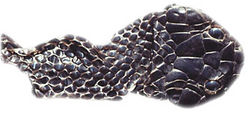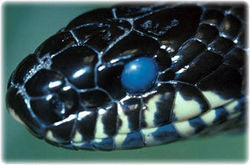Difference between revisions of "Snake Shedding"
| Line 1: | Line 1: | ||
{{review}} | {{review}} | ||
| − | [[Image:Normal_ecdysis_ed.jpg|250px|thumb|right|'''Normal ecdysis of head area (note the shed spectacles)''' © RVC | + | [[Image:Normal_ecdysis_ed.jpg|250px|thumb|right|'''Normal ecdysis of head area (note the shed spectacles)''' © RVC]] |
The entire skin is shed on a regular basis, often two to four times a year. The frequency depends upon the rapidity of growth, age, nutritional state, size and environmental factors which are an important consideration for appropriate [[Snake Housing|snake housing]]. | The entire skin is shed on a regular basis, often two to four times a year. The frequency depends upon the rapidity of growth, age, nutritional state, size and environmental factors which are an important consideration for appropriate [[Snake Housing|snake housing]]. | ||
==The process== | ==The process== | ||
Revision as of 16:11, 11 May 2010
| This article has been peer reviewed but is awaiting expert review. If you would like to help with this, please see more information about expert reviewing. |
The entire skin is shed on a regular basis, often two to four times a year. The frequency depends upon the rapidity of growth, age, nutritional state, size and environmental factors which are an important consideration for appropriate snake housing.
The process
Prior to shedding there is an inactive period of about a week during which the spectacle becomes opaque. Fissure-like clefts form between the inner dividing epidermal cells and the older cells as these migrate outward. A new three layered epidermis is formed under the old outer layers. Lymph diffuses into the area between the old and new skin and enzymes form a cleavage zone. Air is present between the two layers and interferes with ultrasonography. During separation of the old and new epithelium, anaerobic glycolysis assists in separating the outer layer and acid phosphatase breaks down the cementing material.
Ecdysis then occurs as the snake rubs itself on objects in the environment to loosen the old skin. Most snakes shed their skin in one piece, except for the giant snakes that may tear their moult. The process takes in total about two weeks.
For more information on appropriate husbandry, including terrarium furniture that assists in the shedding process, see Snake Housing.
Spectacle
Prior to shedding the spectacle becomes opaque and bluish-white from its normally transparent state. This results from a separation of the spectacle layers by a lymph-like fluid. In the wild this may render the snake partially blind and vulnerable to attack. During the actual shedding the spectacle returns to the transparent state. It is shed with the rest of the skin during ecdysis.
For more information on snake eye anatomy and physiology, see Snake Eye.
Dysecdysis
Dysecdysis is improper or incomplete shedding. It may occur for various reasons including disease (mites, malnutrition, dermatitis or trauma) and problems of captivity (incorrect humidity, incorrect handling). Sometimes the spectacle fails to shed and remains as an opaque cover over the eye, restricting vision.
For more information, see Snake Dysecdysis.
References
Mader, D.R. (2005). Reptile Medicine and Surgery. Saunders. pp. 52. ISBN 072169327X

